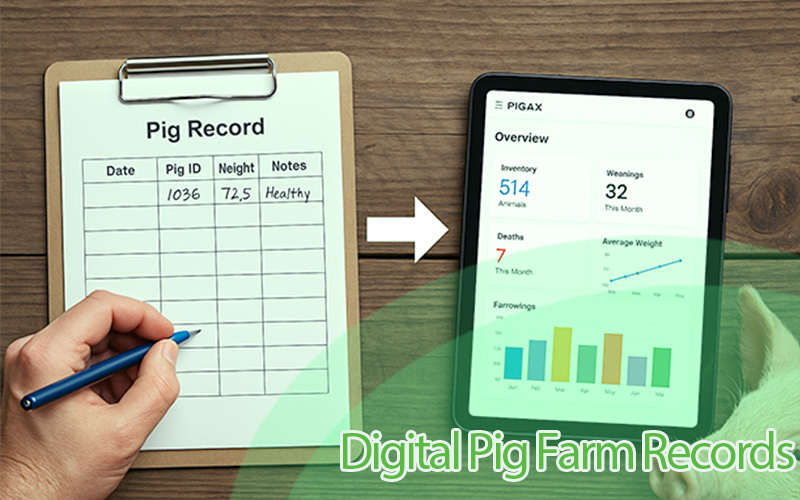Crafting the Perfect Feed Plan Schedule: A Step-by-Step Guide
A pig feed schedule is more than just a timetable; it is a strategic blueprint that ensures each pig receives optimal nutrition at the right times to promote health and growth. The precision of this schedule can significantly influence overall herd health and farm productivity. Farmers can enhance growth rates, improve feed efficiency, and reduce operational costs by meticulously planning feeding times and portions.
This guide will equip you with the essentials of crafting a feed schedule that aligns with your pigs’ needs and the logistical realities of modern farming. Whether you manage a few dozen pigs or thousands, understanding the principles of effective feed scheduling is crucial. From the basics of nutritional requirements to the integration of innovative management tools like Pigax, we'll provide you with the knowledge to optimize your feeding strategy, ensuring your pigs thrive and your business prospers.
What is a Pig Feed Schedule?
A feed schedule, integral to the feed plan, dictates the timing and frequency of feedings. The right schedule helps maintain consistent growth rates and health by ensuring that pigs are neither underfed nor overfed. Effective scheduling aligns with pigs' natural eating behaviors and metabolic needs, which vary by age, weight, and health status.
Basic Information on a Pig Feed Schedule
- Feeding Times:
- The specific times during the day when food is provided. Timing can influence digestion and energy levels, thus affecting the overall well-being and productivity of the pigs.
- Portion Sizes:
- The quantity of food given at each feeding time should be carefully calculated based on the pigs' age, weight, and growth targets. Proper portion control helps prevent underfeeding and overfeeding, both of which can adversely affect health and growth.
- Nutrient Requirements:
- Detailed breakdown of proteins, carbohydrates, fats, vitamins, and minerals needed in the pigs' diet. Each nutrient plays a vital role and must be balanced according to the specific needs of different groups within the pig population, such as lactating sows, weaners, or finishers.
Pigs are naturally inclined to eat in small quantities throughout the day. Therefore, a well-planned feed schedule should mimic this natural grazing behavior as closely as possible, especially in an intensive farming environment. Aligning the feed schedule with these natural behaviors helps reduce stress among the herd and promotes more efficient digestion and nutrient absorption.
Feeding times for each stage
- Young Pigs: Require frequent small meals due to their fast metabolism and limited stomach capacity.
- Mature Pigs: Can handle larger, less frequent meals but benefit from a routine to prevent digestive issues.
- Breeding Stock: Might need adjustments in feed based on reproductive cycles.
Implementing a consistent feed schedule not only helps in managing the quantity and quality of what pigs eat but also in observing their health and growth, allowing for timely adjustments to their diet as needed.
The Role of Consistency and Timing
The effectiveness of a pig feed schedule hinges on its ability to provide a consistent and reliable framework for feeding that suits the biological and behavioral needs of pigs.
Regular feeding times set a rhythm that aligns with the pigs’ internal clocks, reducing stress and enhancing overall well-being. This consistency helps pigs adjust their digestive systems to a set routine, which can decrease the occurrence of gastrointestinal disorders. A well-crafted schedule helps stabilize the pigs' metabolism. This stability is particularly important in environments where pigs are expected to achieve specific growth milestones within set periods.
Step-by-Step Guide to Creating a Pig Feed Schedule
Creating an effective pig feed schedule involves several key steps, from assessing the specific needs of your pigs to implementing and adjusting the schedule based on real-time feedback and observations. This guide will walk you through each step, ensuring that you can craft a schedule that promotes optimal health and productivity.
- Assessing your Pig's need
- Begin by determining the nutritional needs of your pigs based on their age, weight, growth stage, and health condition. This includes understanding the protein, fat, carbohydrate, vitamin, and mineral requirements necessary to support their growth and development.
- Also, take into account the environment in which your pigs are housed. Factors such as temperature, humidity, and the physical layout of the feeding area can influence how and when pigs should be fed.
- Designing the feed schedule
- Decide on the optimal times for feeding that align with your pigs' natural activity periods. For instance, pigs are generally more active during cooler parts of the day, so scheduling feeding times during these periods can enhance feed intake and utilization.
- Establish how often your pigs need to be fed. Younger pigs require more frequent feeding schedules with smaller portion sizes, while older pigs can manage with fewer, larger meals.
- Implement the feed schedule
- Gradually introduce the new feeding schedule to avoid disrupting the pigs’ routines abruptly. A sudden change can cause stress and affect their eating behavior and overall health.
- Implement tools and technology to ensure consistency and precision in feeding. Automated feeders can regulate the amount and frequency of feed, while monitoring systems can help track each pig's feed intake and growth.
- Monitor and adjust the feed schedule
- To ensure that your pig feed schedule is always aligned with the best outcomes for your pigs’ health and productivity, continuous monitoring and timely adjustments are crucial. This process allows you to respond to any changes in growth rates, health status, or environmental conditions that may affect feeding efficiency.
- Follow the following methods to monitor changes:
- Growth Tracking:
- Regularly weigh your pigs and compare their growth to standard growth charts for their breed and age. This helps in identifying whether they are on track, underweight, or overweight.
- Health Monitoring:
- Keep an eye out for signs of health issues such as changes in appetite, lethargy, or abnormal behavior. Early detection of health problems can often be addressed by adjusting their diet or feeding schedule.
- Feed Consumption Analysis:
- Monitor how much feed is being consumed and how much is being wasted. High waste levels might indicate that the feed times or portions are not optimized for the pigs’ current needs.
Common Pitfalls in Pig Feed Scheduling and How to Avoid Them
Effective pig feed scheduling is a complex process that requires careful planning and ongoing attention. However, even with the best intentions, certain common pitfalls can undermine the success of your feeding program. Recognizing and understanding these challenges can help you avoid them and maintain an effective feed schedule.
- Inconsistency in feeding times
- This can disrupt the pigs' internal biological clocks, leading to stress, digestive problems, and irregular growth patterns.
- Establish a strict schedule for feeding times and stick to it as closely as possible. Utilizing automated feeding systems can help maintain this consistency, especially in larger operations.
- Overfeeding and Underfeeding
- Incorrect portion sizes can lead to overfeeding or underfeeding, both of which are detrimental to pig health and can lead to obesity or malnutrition.
- Regularly assess the growth and health of your pigs to adjust feed portions accurately. Precision feeding technologies can automatically adjust feed amounts based on real-time data, ensuring optimal nutrition.
- Neglecting Nutrient Balance
- Failing to provide a balanced diet that meets all nutritional needs can affect the overall health and productivity of pigs. Work with a nutritionist to develop a feed formulation that meets the specific requirements of your pigs at different stages of their life cycle. Regularly review and update the feed composition as needed.
- Failure to use Pig management software
- A manual approach to feeding schedules can lead to errors and inefficiencies, particularly as the size of the operation grows.
- Implement pig management software like Pigax, which can help streamline the creation and management of feed schedules, monitor pig health and growth, and provide actionable insights based on collected data.
-
Pig Scheduling With Pigax
Pigax is a revolutionary pig management software designed to streamline and optimize the complex tasks associated with pig farming. This tool is especially beneficial for managing feed schedules, tracking animal health, and enhancing overall farm efficiency.
How Pigax Enhances Feed Scheduling
- Automated Feed Scheduling:
- Pigax offers features that automate the creation and execution of feed schedules, ensuring precise timing and portion control based on real-time data and predictive analytics.
- Health Monitoring Integration:
- The software seamlessly integrates health monitoring data, adjusting feed schedules based on individual health indicators and environmental changes.
- Data Analytics:
- Pigax provides powerful analytics that helps farmers understand trends, forecast needs, and make informed decisions, thus reducing waste and increasing productivity.
Conclusion
Crafting the perfect pig feed schedule is a dynamic and ongoing process that requires careful planning, continuous monitoring, and regular adjustments. By following the steps outlined in this guide, you can create a feeding program that promotes the health, growth, and productivity of your pigs. Remember, the key to successful pig feed scheduling lies in understanding the specific needs of your herd, leveraging the latest technologies like Pigax, and being adaptable to change.




